Report on the International Tourism System and Development in Cuba
VerifiedAdded on 2022/10/02
|12
|3780
|365
Report
AI Summary
This report provides a comprehensive analysis of the international tourism system in Cuba. It begins with an executive summary, followed by an introduction that highlights Cuba's growing tourism sector. The report then delves into the historical development of tourism in Cuba, tracing its evolution and the impact of economic and political changes, including the U.S. embargo. It analyzes international tourism visitation trends, including fluctuations and growth patterns. The report also explores destination attractiveness through the lens of motivation, satisfaction, and attraction theories, examining Cuba's unique offerings and challenges. Furthermore, the report assesses the positive and negative impacts of tourism on the host community, including economic benefits and social issues. It analyzes destination development issues and tourism policy concerns, concluding with recommendations for improving the tourism industry to attract more visitors. The report uses references to support its findings.
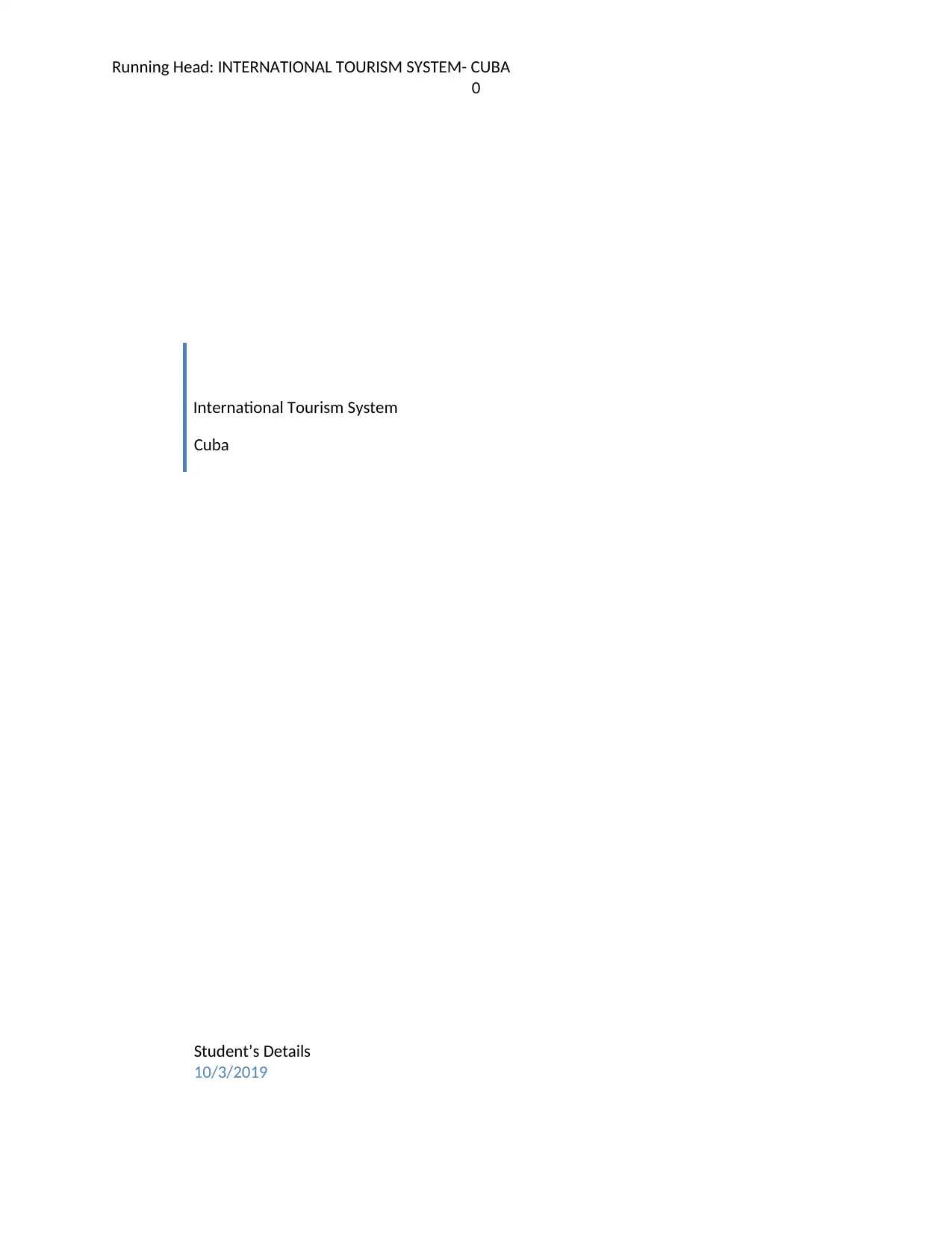
Running Head: INTERNATIONAL TOURISM SYSTEM- CUBA
0
International Tourism System
Cuba
Student’s Details
10/3/2019
0
International Tourism System
Cuba
Student’s Details
10/3/2019
Paraphrase This Document
Need a fresh take? Get an instant paraphrase of this document with our AI Paraphraser
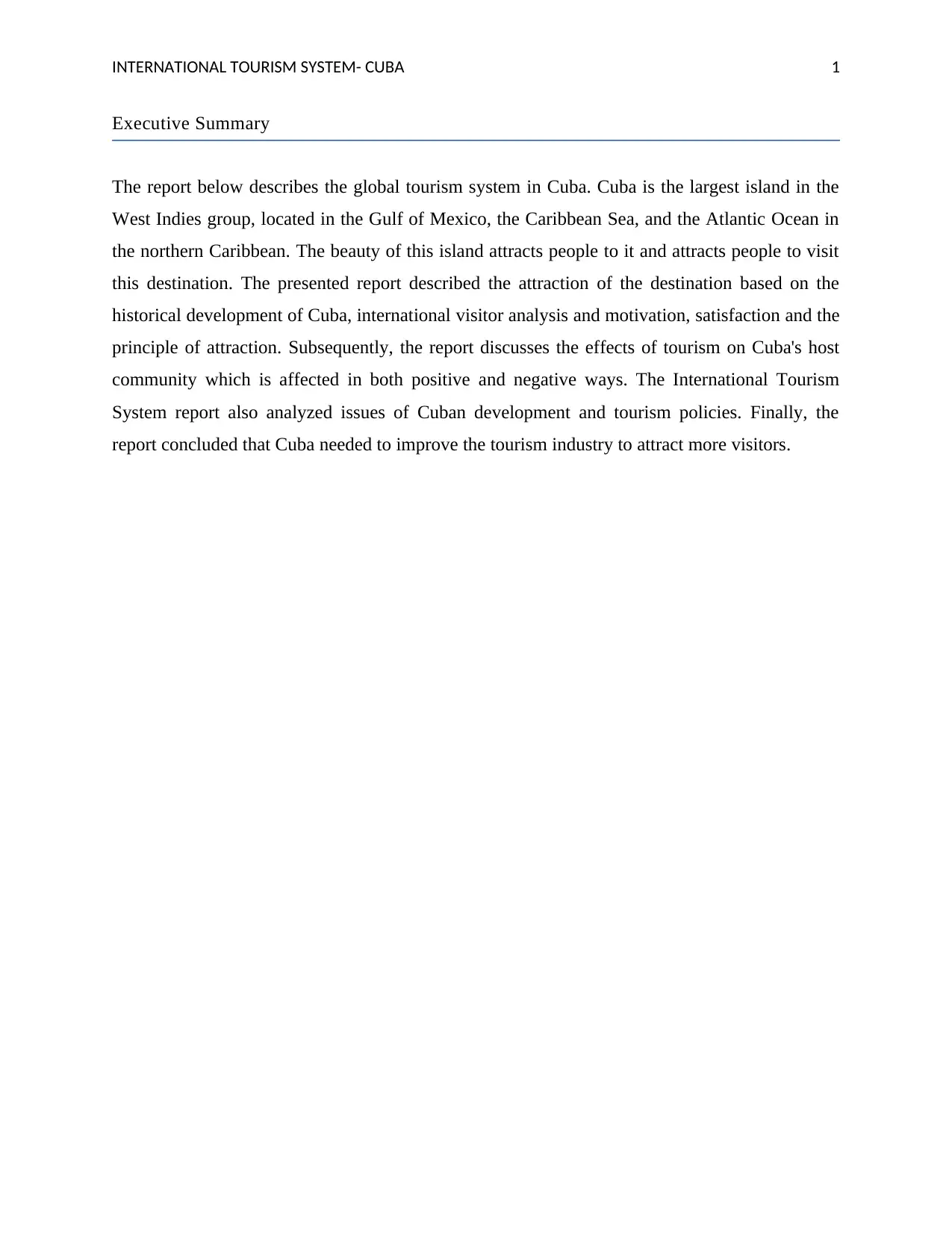
INTERNATIONAL TOURISM SYSTEM- CUBA 1
Executive Summary
The report below describes the global tourism system in Cuba. Cuba is the largest island in the
West Indies group, located in the Gulf of Mexico, the Caribbean Sea, and the Atlantic Ocean in
the northern Caribbean. The beauty of this island attracts people to it and attracts people to visit
this destination. The presented report described the attraction of the destination based on the
historical development of Cuba, international visitor analysis and motivation, satisfaction and the
principle of attraction. Subsequently, the report discusses the effects of tourism on Cuba's host
community which is affected in both positive and negative ways. The International Tourism
System report also analyzed issues of Cuban development and tourism policies. Finally, the
report concluded that Cuba needed to improve the tourism industry to attract more visitors.
Executive Summary
The report below describes the global tourism system in Cuba. Cuba is the largest island in the
West Indies group, located in the Gulf of Mexico, the Caribbean Sea, and the Atlantic Ocean in
the northern Caribbean. The beauty of this island attracts people to it and attracts people to visit
this destination. The presented report described the attraction of the destination based on the
historical development of Cuba, international visitor analysis and motivation, satisfaction and the
principle of attraction. Subsequently, the report discusses the effects of tourism on Cuba's host
community which is affected in both positive and negative ways. The International Tourism
System report also analyzed issues of Cuban development and tourism policies. Finally, the
report concluded that Cuba needed to improve the tourism industry to attract more visitors.
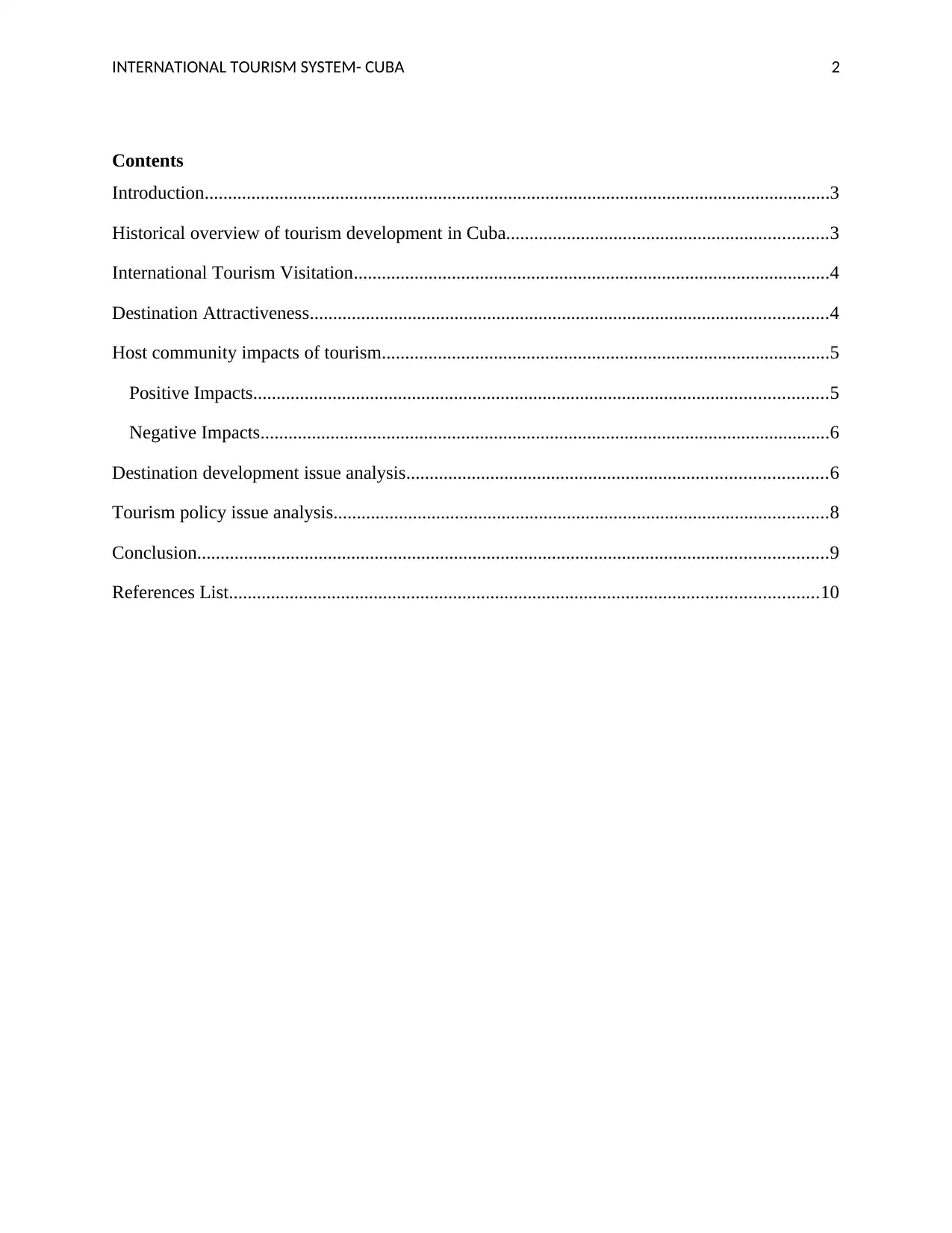
INTERNATIONAL TOURISM SYSTEM- CUBA 2
Contents
Introduction......................................................................................................................................3
Historical overview of tourism development in Cuba.....................................................................3
International Tourism Visitation......................................................................................................4
Destination Attractiveness...............................................................................................................4
Host community impacts of tourism................................................................................................5
Positive Impacts...........................................................................................................................5
Negative Impacts..........................................................................................................................6
Destination development issue analysis..........................................................................................6
Tourism policy issue analysis..........................................................................................................8
Conclusion.......................................................................................................................................9
References List..............................................................................................................................10
Contents
Introduction......................................................................................................................................3
Historical overview of tourism development in Cuba.....................................................................3
International Tourism Visitation......................................................................................................4
Destination Attractiveness...............................................................................................................4
Host community impacts of tourism................................................................................................5
Positive Impacts...........................................................................................................................5
Negative Impacts..........................................................................................................................6
Destination development issue analysis..........................................................................................6
Tourism policy issue analysis..........................................................................................................8
Conclusion.......................................................................................................................................9
References List..............................................................................................................................10
⊘ This is a preview!⊘
Do you want full access?
Subscribe today to unlock all pages.

Trusted by 1+ million students worldwide
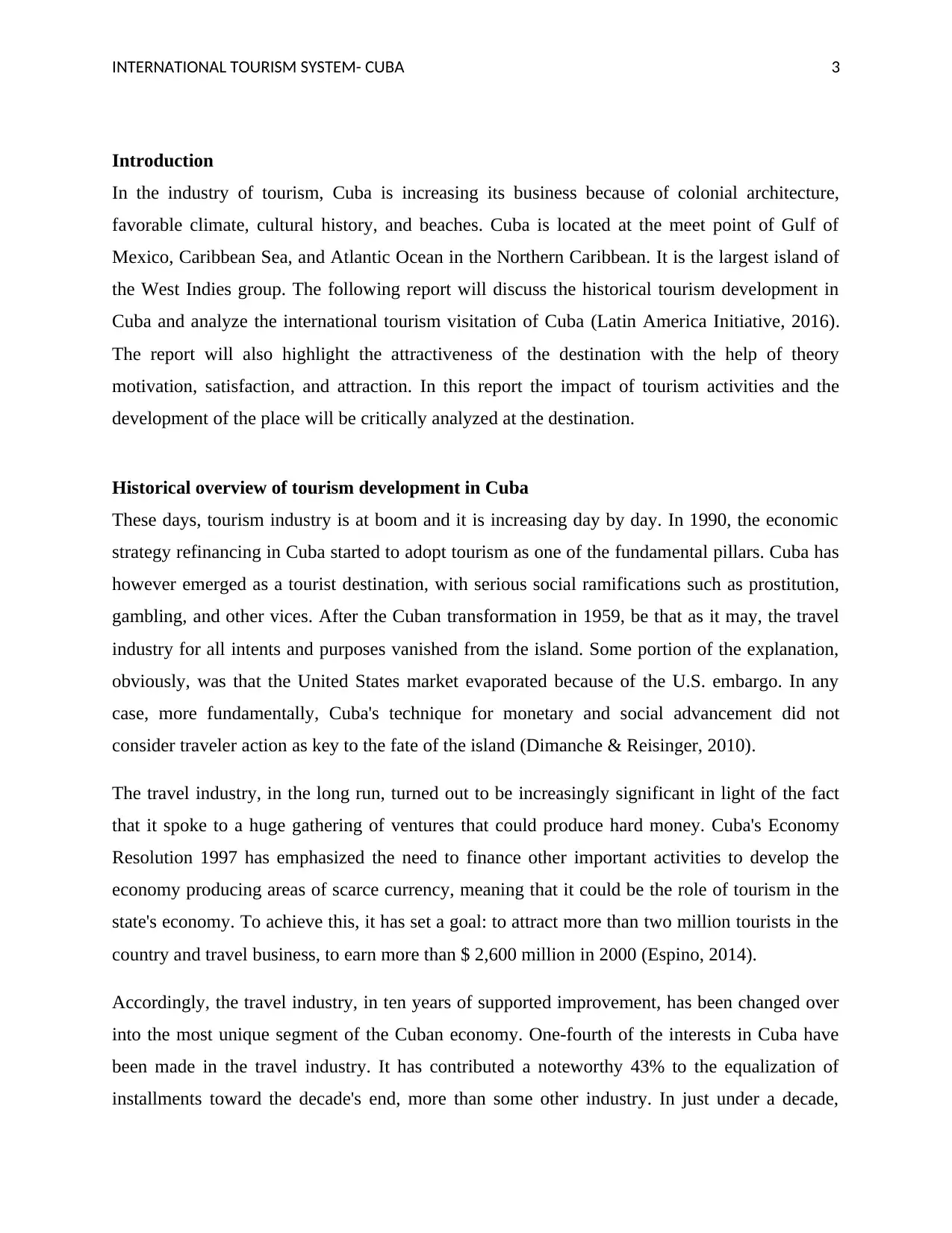
INTERNATIONAL TOURISM SYSTEM- CUBA 3
Introduction
In the industry of tourism, Cuba is increasing its business because of colonial architecture,
favorable climate, cultural history, and beaches. Cuba is located at the meet point of Gulf of
Mexico, Caribbean Sea, and Atlantic Ocean in the Northern Caribbean. It is the largest island of
the West Indies group. The following report will discuss the historical tourism development in
Cuba and analyze the international tourism visitation of Cuba (Latin America Initiative, 2016).
The report will also highlight the attractiveness of the destination with the help of theory
motivation, satisfaction, and attraction. In this report the impact of tourism activities and the
development of the place will be critically analyzed at the destination.
Historical overview of tourism development in Cuba
These days, tourism industry is at boom and it is increasing day by day. In 1990, the economic
strategy refinancing in Cuba started to adopt tourism as one of the fundamental pillars. Cuba has
however emerged as a tourist destination, with serious social ramifications such as prostitution,
gambling, and other vices. After the Cuban transformation in 1959, be that as it may, the travel
industry for all intents and purposes vanished from the island. Some portion of the explanation,
obviously, was that the United States market evaporated because of the U.S. embargo. In any
case, more fundamentally, Cuba's technique for monetary and social advancement did not
consider traveler action as key to the fate of the island (Dimanche & Reisinger, 2010).
The travel industry, in the long run, turned out to be increasingly significant in light of the fact
that it spoke to a huge gathering of ventures that could produce hard money. Cuba's Economy
Resolution 1997 has emphasized the need to finance other important activities to develop the
economy producing areas of scarce currency, meaning that it could be the role of tourism in the
state's economy. To achieve this, it has set a goal: to attract more than two million tourists in the
country and travel business, to earn more than $ 2,600 million in 2000 (Espino, 2014).
Accordingly, the travel industry, in ten years of supported improvement, has been changed over
into the most unique segment of the Cuban economy. One-fourth of the interests in Cuba have
been made in the travel industry. It has contributed a noteworthy 43% to the equalization of
installments toward the decade's end, more than some other industry. In just under a decade,
Introduction
In the industry of tourism, Cuba is increasing its business because of colonial architecture,
favorable climate, cultural history, and beaches. Cuba is located at the meet point of Gulf of
Mexico, Caribbean Sea, and Atlantic Ocean in the Northern Caribbean. It is the largest island of
the West Indies group. The following report will discuss the historical tourism development in
Cuba and analyze the international tourism visitation of Cuba (Latin America Initiative, 2016).
The report will also highlight the attractiveness of the destination with the help of theory
motivation, satisfaction, and attraction. In this report the impact of tourism activities and the
development of the place will be critically analyzed at the destination.
Historical overview of tourism development in Cuba
These days, tourism industry is at boom and it is increasing day by day. In 1990, the economic
strategy refinancing in Cuba started to adopt tourism as one of the fundamental pillars. Cuba has
however emerged as a tourist destination, with serious social ramifications such as prostitution,
gambling, and other vices. After the Cuban transformation in 1959, be that as it may, the travel
industry for all intents and purposes vanished from the island. Some portion of the explanation,
obviously, was that the United States market evaporated because of the U.S. embargo. In any
case, more fundamentally, Cuba's technique for monetary and social advancement did not
consider traveler action as key to the fate of the island (Dimanche & Reisinger, 2010).
The travel industry, in the long run, turned out to be increasingly significant in light of the fact
that it spoke to a huge gathering of ventures that could produce hard money. Cuba's Economy
Resolution 1997 has emphasized the need to finance other important activities to develop the
economy producing areas of scarce currency, meaning that it could be the role of tourism in the
state's economy. To achieve this, it has set a goal: to attract more than two million tourists in the
country and travel business, to earn more than $ 2,600 million in 2000 (Espino, 2014).
Accordingly, the travel industry, in ten years of supported improvement, has been changed over
into the most unique segment of the Cuban economy. One-fourth of the interests in Cuba have
been made in the travel industry. It has contributed a noteworthy 43% to the equalization of
installments toward the decade's end, more than some other industry. In just under a decade,
Paraphrase This Document
Need a fresh take? Get an instant paraphrase of this document with our AI Paraphraser
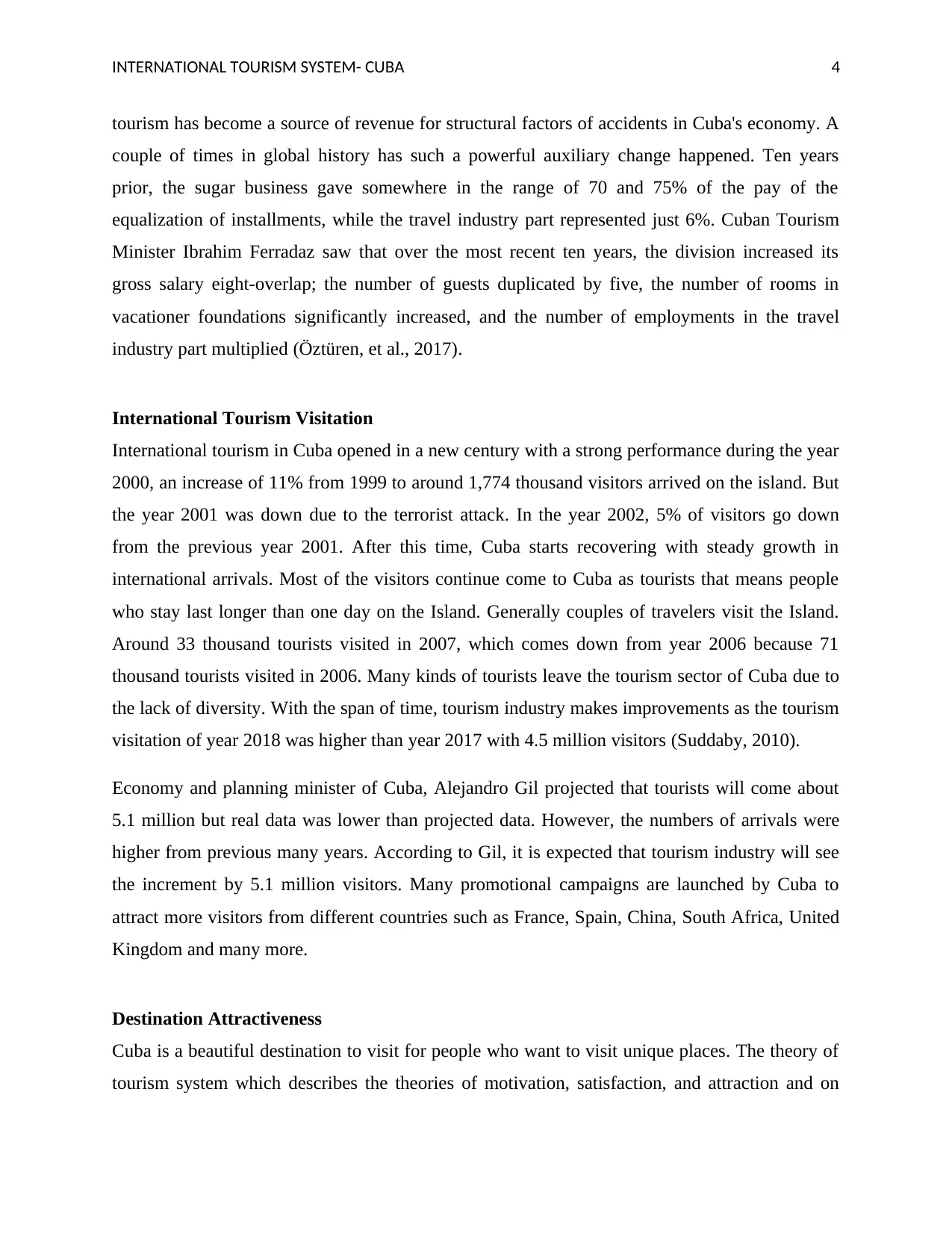
INTERNATIONAL TOURISM SYSTEM- CUBA 4
tourism has become a source of revenue for structural factors of accidents in Cuba's economy. A
couple of times in global history has such a powerful auxiliary change happened. Ten years
prior, the sugar business gave somewhere in the range of 70 and 75% of the pay of the
equalization of installments, while the travel industry part represented just 6%. Cuban Tourism
Minister Ibrahim Ferradaz saw that over the most recent ten years, the division increased its
gross salary eight-overlap; the number of guests duplicated by five, the number of rooms in
vacationer foundations significantly increased, and the number of employments in the travel
industry part multiplied (Öztüren, et al., 2017).
International Tourism Visitation
International tourism in Cuba opened in a new century with a strong performance during the year
2000, an increase of 11% from 1999 to around 1,774 thousand visitors arrived on the island. But
the year 2001 was down due to the terrorist attack. In the year 2002, 5% of visitors go down
from the previous year 2001. After this time, Cuba starts recovering with steady growth in
international arrivals. Most of the visitors continue come to Cuba as tourists that means people
who stay last longer than one day on the Island. Generally couples of travelers visit the Island.
Around 33 thousand tourists visited in 2007, which comes down from year 2006 because 71
thousand tourists visited in 2006. Many kinds of tourists leave the tourism sector of Cuba due to
the lack of diversity. With the span of time, tourism industry makes improvements as the tourism
visitation of year 2018 was higher than year 2017 with 4.5 million visitors (Suddaby, 2010).
Economy and planning minister of Cuba, Alejandro Gil projected that tourists will come about
5.1 million but real data was lower than projected data. However, the numbers of arrivals were
higher from previous many years. According to Gil, it is expected that tourism industry will see
the increment by 5.1 million visitors. Many promotional campaigns are launched by Cuba to
attract more visitors from different countries such as France, Spain, China, South Africa, United
Kingdom and many more.
Destination Attractiveness
Cuba is a beautiful destination to visit for people who want to visit unique places. The theory of
tourism system which describes the theories of motivation, satisfaction, and attraction and on
tourism has become a source of revenue for structural factors of accidents in Cuba's economy. A
couple of times in global history has such a powerful auxiliary change happened. Ten years
prior, the sugar business gave somewhere in the range of 70 and 75% of the pay of the
equalization of installments, while the travel industry part represented just 6%. Cuban Tourism
Minister Ibrahim Ferradaz saw that over the most recent ten years, the division increased its
gross salary eight-overlap; the number of guests duplicated by five, the number of rooms in
vacationer foundations significantly increased, and the number of employments in the travel
industry part multiplied (Öztüren, et al., 2017).
International Tourism Visitation
International tourism in Cuba opened in a new century with a strong performance during the year
2000, an increase of 11% from 1999 to around 1,774 thousand visitors arrived on the island. But
the year 2001 was down due to the terrorist attack. In the year 2002, 5% of visitors go down
from the previous year 2001. After this time, Cuba starts recovering with steady growth in
international arrivals. Most of the visitors continue come to Cuba as tourists that means people
who stay last longer than one day on the Island. Generally couples of travelers visit the Island.
Around 33 thousand tourists visited in 2007, which comes down from year 2006 because 71
thousand tourists visited in 2006. Many kinds of tourists leave the tourism sector of Cuba due to
the lack of diversity. With the span of time, tourism industry makes improvements as the tourism
visitation of year 2018 was higher than year 2017 with 4.5 million visitors (Suddaby, 2010).
Economy and planning minister of Cuba, Alejandro Gil projected that tourists will come about
5.1 million but real data was lower than projected data. However, the numbers of arrivals were
higher from previous many years. According to Gil, it is expected that tourism industry will see
the increment by 5.1 million visitors. Many promotional campaigns are launched by Cuba to
attract more visitors from different countries such as France, Spain, China, South Africa, United
Kingdom and many more.
Destination Attractiveness
Cuba is a beautiful destination to visit for people who want to visit unique places. The theory of
tourism system which describes the theories of motivation, satisfaction, and attraction and on
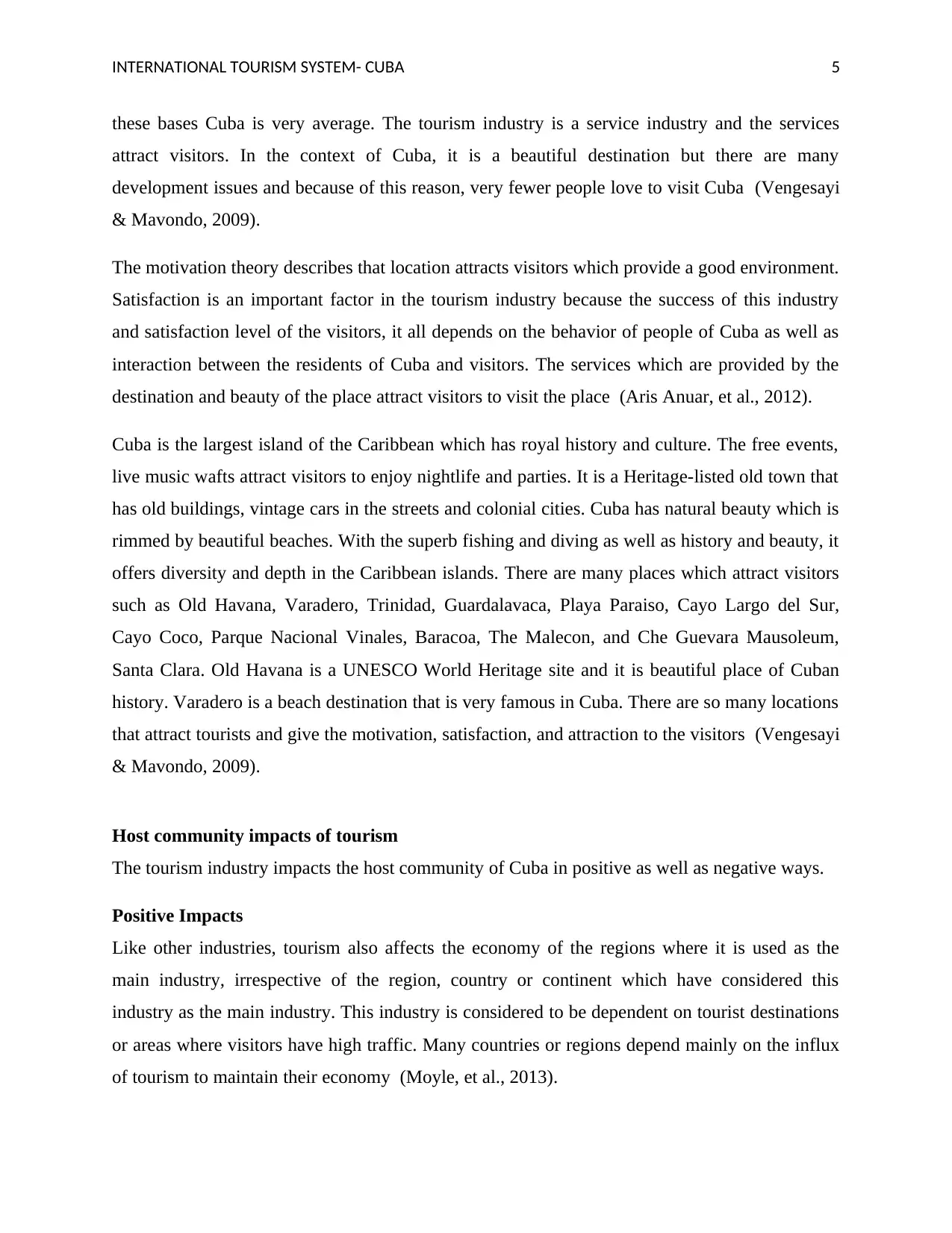
INTERNATIONAL TOURISM SYSTEM- CUBA 5
these bases Cuba is very average. The tourism industry is a service industry and the services
attract visitors. In the context of Cuba, it is a beautiful destination but there are many
development issues and because of this reason, very fewer people love to visit Cuba (Vengesayi
& Mavondo, 2009).
The motivation theory describes that location attracts visitors which provide a good environment.
Satisfaction is an important factor in the tourism industry because the success of this industry
and satisfaction level of the visitors, it all depends on the behavior of people of Cuba as well as
interaction between the residents of Cuba and visitors. The services which are provided by the
destination and beauty of the place attract visitors to visit the place (Aris Anuar, et al., 2012).
Cuba is the largest island of the Caribbean which has royal history and culture. The free events,
live music wafts attract visitors to enjoy nightlife and parties. It is a Heritage-listed old town that
has old buildings, vintage cars in the streets and colonial cities. Cuba has natural beauty which is
rimmed by beautiful beaches. With the superb fishing and diving as well as history and beauty, it
offers diversity and depth in the Caribbean islands. There are many places which attract visitors
such as Old Havana, Varadero, Trinidad, Guardalavaca, Playa Paraiso, Cayo Largo del Sur,
Cayo Coco, Parque Nacional Vinales, Baracoa, The Malecon, and Che Guevara Mausoleum,
Santa Clara. Old Havana is a UNESCO World Heritage site and it is beautiful place of Cuban
history. Varadero is a beach destination that is very famous in Cuba. There are so many locations
that attract tourists and give the motivation, satisfaction, and attraction to the visitors (Vengesayi
& Mavondo, 2009).
Host community impacts of tourism
The tourism industry impacts the host community of Cuba in positive as well as negative ways.
Positive Impacts
Like other industries, tourism also affects the economy of the regions where it is used as the
main industry, irrespective of the region, country or continent which have considered this
industry as the main industry. This industry is considered to be dependent on tourist destinations
or areas where visitors have high traffic. Many countries or regions depend mainly on the influx
of tourism to maintain their economy (Moyle, et al., 2013).
these bases Cuba is very average. The tourism industry is a service industry and the services
attract visitors. In the context of Cuba, it is a beautiful destination but there are many
development issues and because of this reason, very fewer people love to visit Cuba (Vengesayi
& Mavondo, 2009).
The motivation theory describes that location attracts visitors which provide a good environment.
Satisfaction is an important factor in the tourism industry because the success of this industry
and satisfaction level of the visitors, it all depends on the behavior of people of Cuba as well as
interaction between the residents of Cuba and visitors. The services which are provided by the
destination and beauty of the place attract visitors to visit the place (Aris Anuar, et al., 2012).
Cuba is the largest island of the Caribbean which has royal history and culture. The free events,
live music wafts attract visitors to enjoy nightlife and parties. It is a Heritage-listed old town that
has old buildings, vintage cars in the streets and colonial cities. Cuba has natural beauty which is
rimmed by beautiful beaches. With the superb fishing and diving as well as history and beauty, it
offers diversity and depth in the Caribbean islands. There are many places which attract visitors
such as Old Havana, Varadero, Trinidad, Guardalavaca, Playa Paraiso, Cayo Largo del Sur,
Cayo Coco, Parque Nacional Vinales, Baracoa, The Malecon, and Che Guevara Mausoleum,
Santa Clara. Old Havana is a UNESCO World Heritage site and it is beautiful place of Cuban
history. Varadero is a beach destination that is very famous in Cuba. There are so many locations
that attract tourists and give the motivation, satisfaction, and attraction to the visitors (Vengesayi
& Mavondo, 2009).
Host community impacts of tourism
The tourism industry impacts the host community of Cuba in positive as well as negative ways.
Positive Impacts
Like other industries, tourism also affects the economy of the regions where it is used as the
main industry, irrespective of the region, country or continent which have considered this
industry as the main industry. This industry is considered to be dependent on tourist destinations
or areas where visitors have high traffic. Many countries or regions depend mainly on the influx
of tourism to maintain their economy (Moyle, et al., 2013).
⊘ This is a preview!⊘
Do you want full access?
Subscribe today to unlock all pages.

Trusted by 1+ million students worldwide
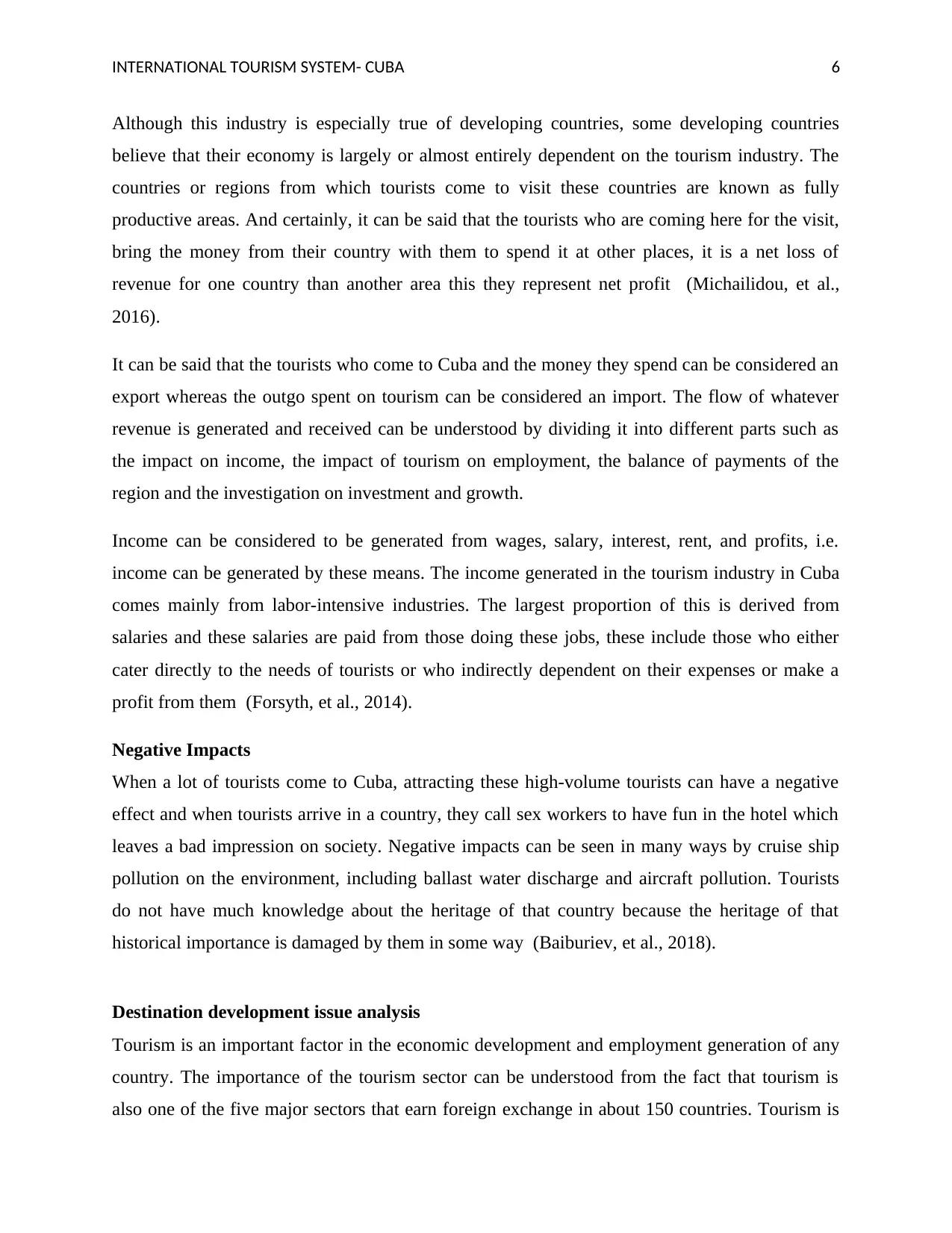
INTERNATIONAL TOURISM SYSTEM- CUBA 6
Although this industry is especially true of developing countries, some developing countries
believe that their economy is largely or almost entirely dependent on the tourism industry. The
countries or regions from which tourists come to visit these countries are known as fully
productive areas. And certainly, it can be said that the tourists who are coming here for the visit,
bring the money from their country with them to spend it at other places, it is a net loss of
revenue for one country than another area this they represent net profit (Michailidou, et al.,
2016).
It can be said that the tourists who come to Cuba and the money they spend can be considered an
export whereas the outgo spent on tourism can be considered an import. The flow of whatever
revenue is generated and received can be understood by dividing it into different parts such as
the impact on income, the impact of tourism on employment, the balance of payments of the
region and the investigation on investment and growth.
Income can be considered to be generated from wages, salary, interest, rent, and profits, i.e.
income can be generated by these means. The income generated in the tourism industry in Cuba
comes mainly from labor-intensive industries. The largest proportion of this is derived from
salaries and these salaries are paid from those doing these jobs, these include those who either
cater directly to the needs of tourists or who indirectly dependent on their expenses or make a
profit from them (Forsyth, et al., 2014).
Negative Impacts
When a lot of tourists come to Cuba, attracting these high-volume tourists can have a negative
effect and when tourists arrive in a country, they call sex workers to have fun in the hotel which
leaves a bad impression on society. Negative impacts can be seen in many ways by cruise ship
pollution on the environment, including ballast water discharge and aircraft pollution. Tourists
do not have much knowledge about the heritage of that country because the heritage of that
historical importance is damaged by them in some way (Baiburiev, et al., 2018).
Destination development issue analysis
Tourism is an important factor in the economic development and employment generation of any
country. The importance of the tourism sector can be understood from the fact that tourism is
also one of the five major sectors that earn foreign exchange in about 150 countries. Tourism is
Although this industry is especially true of developing countries, some developing countries
believe that their economy is largely or almost entirely dependent on the tourism industry. The
countries or regions from which tourists come to visit these countries are known as fully
productive areas. And certainly, it can be said that the tourists who are coming here for the visit,
bring the money from their country with them to spend it at other places, it is a net loss of
revenue for one country than another area this they represent net profit (Michailidou, et al.,
2016).
It can be said that the tourists who come to Cuba and the money they spend can be considered an
export whereas the outgo spent on tourism can be considered an import. The flow of whatever
revenue is generated and received can be understood by dividing it into different parts such as
the impact on income, the impact of tourism on employment, the balance of payments of the
region and the investigation on investment and growth.
Income can be considered to be generated from wages, salary, interest, rent, and profits, i.e.
income can be generated by these means. The income generated in the tourism industry in Cuba
comes mainly from labor-intensive industries. The largest proportion of this is derived from
salaries and these salaries are paid from those doing these jobs, these include those who either
cater directly to the needs of tourists or who indirectly dependent on their expenses or make a
profit from them (Forsyth, et al., 2014).
Negative Impacts
When a lot of tourists come to Cuba, attracting these high-volume tourists can have a negative
effect and when tourists arrive in a country, they call sex workers to have fun in the hotel which
leaves a bad impression on society. Negative impacts can be seen in many ways by cruise ship
pollution on the environment, including ballast water discharge and aircraft pollution. Tourists
do not have much knowledge about the heritage of that country because the heritage of that
historical importance is damaged by them in some way (Baiburiev, et al., 2018).
Destination development issue analysis
Tourism is an important factor in the economic development and employment generation of any
country. The importance of the tourism sector can be understood from the fact that tourism is
also one of the five major sectors that earn foreign exchange in about 150 countries. Tourism is
Paraphrase This Document
Need a fresh take? Get an instant paraphrase of this document with our AI Paraphraser
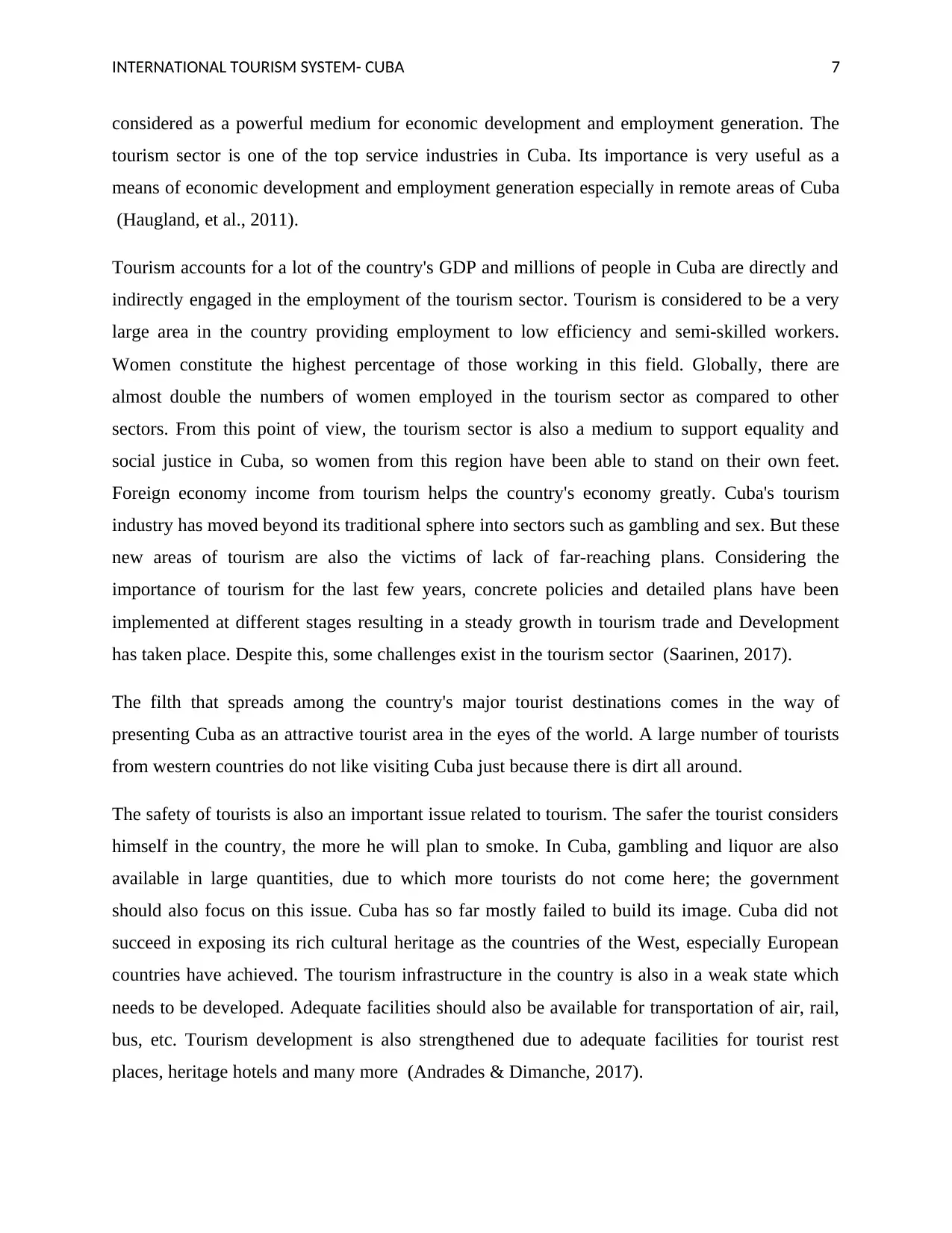
INTERNATIONAL TOURISM SYSTEM- CUBA 7
considered as a powerful medium for economic development and employment generation. The
tourism sector is one of the top service industries in Cuba. Its importance is very useful as a
means of economic development and employment generation especially in remote areas of Cuba
(Haugland, et al., 2011).
Tourism accounts for a lot of the country's GDP and millions of people in Cuba are directly and
indirectly engaged in the employment of the tourism sector. Tourism is considered to be a very
large area in the country providing employment to low efficiency and semi-skilled workers.
Women constitute the highest percentage of those working in this field. Globally, there are
almost double the numbers of women employed in the tourism sector as compared to other
sectors. From this point of view, the tourism sector is also a medium to support equality and
social justice in Cuba, so women from this region have been able to stand on their own feet.
Foreign economy income from tourism helps the country's economy greatly. Cuba's tourism
industry has moved beyond its traditional sphere into sectors such as gambling and sex. But these
new areas of tourism are also the victims of lack of far-reaching plans. Considering the
importance of tourism for the last few years, concrete policies and detailed plans have been
implemented at different stages resulting in a steady growth in tourism trade and Development
has taken place. Despite this, some challenges exist in the tourism sector (Saarinen, 2017).
The filth that spreads among the country's major tourist destinations comes in the way of
presenting Cuba as an attractive tourist area in the eyes of the world. A large number of tourists
from western countries do not like visiting Cuba just because there is dirt all around.
The safety of tourists is also an important issue related to tourism. The safer the tourist considers
himself in the country, the more he will plan to smoke. In Cuba, gambling and liquor are also
available in large quantities, due to which more tourists do not come here; the government
should also focus on this issue. Cuba has so far mostly failed to build its image. Cuba did not
succeed in exposing its rich cultural heritage as the countries of the West, especially European
countries have achieved. The tourism infrastructure in the country is also in a weak state which
needs to be developed. Adequate facilities should also be available for transportation of air, rail,
bus, etc. Tourism development is also strengthened due to adequate facilities for tourist rest
places, heritage hotels and many more (Andrades & Dimanche, 2017).
considered as a powerful medium for economic development and employment generation. The
tourism sector is one of the top service industries in Cuba. Its importance is very useful as a
means of economic development and employment generation especially in remote areas of Cuba
(Haugland, et al., 2011).
Tourism accounts for a lot of the country's GDP and millions of people in Cuba are directly and
indirectly engaged in the employment of the tourism sector. Tourism is considered to be a very
large area in the country providing employment to low efficiency and semi-skilled workers.
Women constitute the highest percentage of those working in this field. Globally, there are
almost double the numbers of women employed in the tourism sector as compared to other
sectors. From this point of view, the tourism sector is also a medium to support equality and
social justice in Cuba, so women from this region have been able to stand on their own feet.
Foreign economy income from tourism helps the country's economy greatly. Cuba's tourism
industry has moved beyond its traditional sphere into sectors such as gambling and sex. But these
new areas of tourism are also the victims of lack of far-reaching plans. Considering the
importance of tourism for the last few years, concrete policies and detailed plans have been
implemented at different stages resulting in a steady growth in tourism trade and Development
has taken place. Despite this, some challenges exist in the tourism sector (Saarinen, 2017).
The filth that spreads among the country's major tourist destinations comes in the way of
presenting Cuba as an attractive tourist area in the eyes of the world. A large number of tourists
from western countries do not like visiting Cuba just because there is dirt all around.
The safety of tourists is also an important issue related to tourism. The safer the tourist considers
himself in the country, the more he will plan to smoke. In Cuba, gambling and liquor are also
available in large quantities, due to which more tourists do not come here; the government
should also focus on this issue. Cuba has so far mostly failed to build its image. Cuba did not
succeed in exposing its rich cultural heritage as the countries of the West, especially European
countries have achieved. The tourism infrastructure in the country is also in a weak state which
needs to be developed. Adequate facilities should also be available for transportation of air, rail,
bus, etc. Tourism development is also strengthened due to adequate facilities for tourist rest
places, heritage hotels and many more (Andrades & Dimanche, 2017).
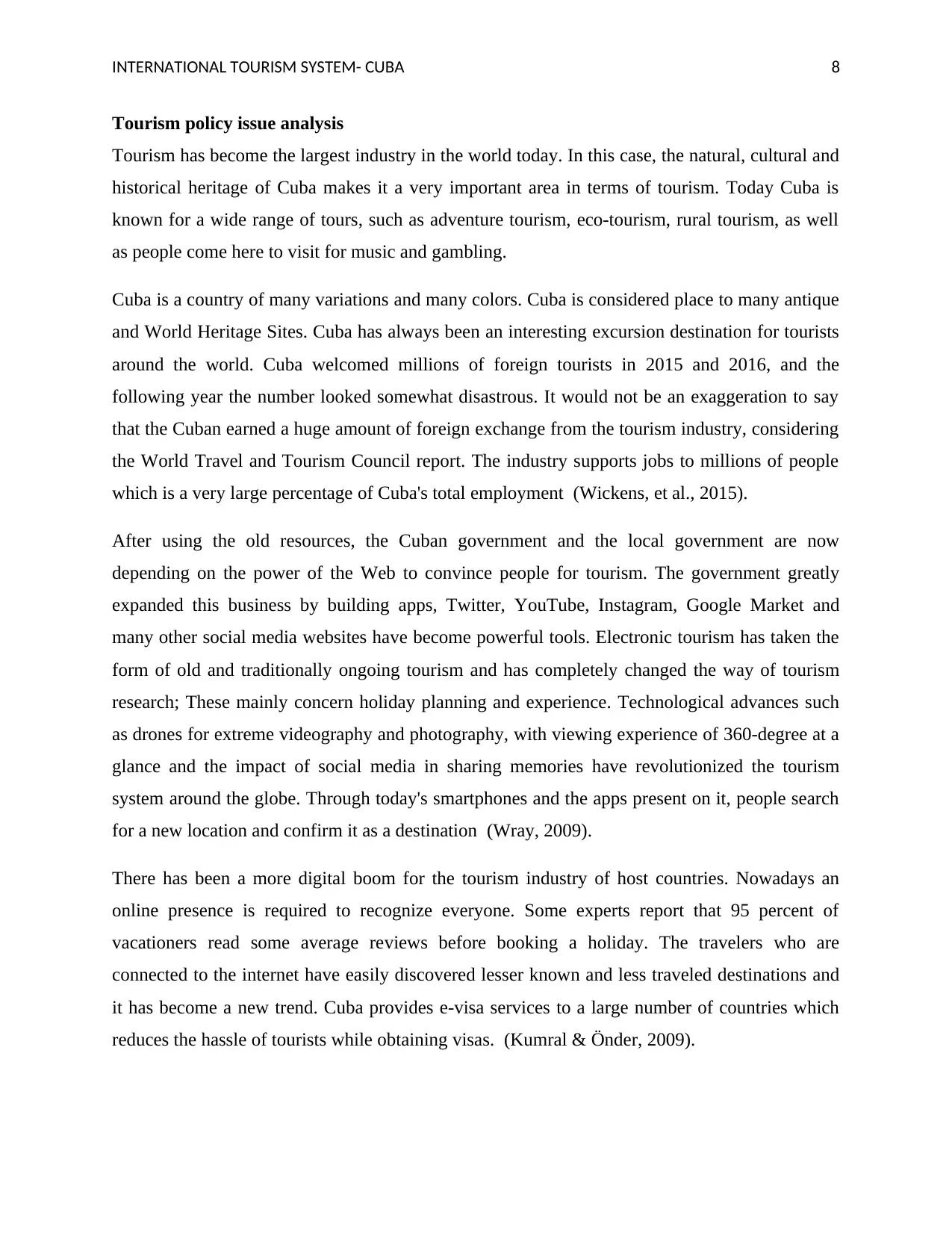
INTERNATIONAL TOURISM SYSTEM- CUBA 8
Tourism policy issue analysis
Tourism has become the largest industry in the world today. In this case, the natural, cultural and
historical heritage of Cuba makes it a very important area in terms of tourism. Today Cuba is
known for a wide range of tours, such as adventure tourism, eco-tourism, rural tourism, as well
as people come here to visit for music and gambling.
Cuba is a country of many variations and many colors. Cuba is considered place to many antique
and World Heritage Sites. Cuba has always been an interesting excursion destination for tourists
around the world. Cuba welcomed millions of foreign tourists in 2015 and 2016, and the
following year the number looked somewhat disastrous. It would not be an exaggeration to say
that the Cuban earned a huge amount of foreign exchange from the tourism industry, considering
the World Travel and Tourism Council report. The industry supports jobs to millions of people
which is a very large percentage of Cuba's total employment (Wickens, et al., 2015).
After using the old resources, the Cuban government and the local government are now
depending on the power of the Web to convince people for tourism. The government greatly
expanded this business by building apps, Twitter, YouTube, Instagram, Google Market and
many other social media websites have become powerful tools. Electronic tourism has taken the
form of old and traditionally ongoing tourism and has completely changed the way of tourism
research; These mainly concern holiday planning and experience. Technological advances such
as drones for extreme videography and photography, with viewing experience of 360-degree at a
glance and the impact of social media in sharing memories have revolutionized the tourism
system around the globe. Through today's smartphones and the apps present on it, people search
for a new location and confirm it as a destination (Wray, 2009).
There has been a more digital boom for the tourism industry of host countries. Nowadays an
online presence is required to recognize everyone. Some experts report that 95 percent of
vacationers read some average reviews before booking a holiday. The travelers who are
connected to the internet have easily discovered lesser known and less traveled destinations and
it has become a new trend. Cuba provides e-visa services to a large number of countries which
reduces the hassle of tourists while obtaining visas. (Kumral & Önder, 2009).
Tourism policy issue analysis
Tourism has become the largest industry in the world today. In this case, the natural, cultural and
historical heritage of Cuba makes it a very important area in terms of tourism. Today Cuba is
known for a wide range of tours, such as adventure tourism, eco-tourism, rural tourism, as well
as people come here to visit for music and gambling.
Cuba is a country of many variations and many colors. Cuba is considered place to many antique
and World Heritage Sites. Cuba has always been an interesting excursion destination for tourists
around the world. Cuba welcomed millions of foreign tourists in 2015 and 2016, and the
following year the number looked somewhat disastrous. It would not be an exaggeration to say
that the Cuban earned a huge amount of foreign exchange from the tourism industry, considering
the World Travel and Tourism Council report. The industry supports jobs to millions of people
which is a very large percentage of Cuba's total employment (Wickens, et al., 2015).
After using the old resources, the Cuban government and the local government are now
depending on the power of the Web to convince people for tourism. The government greatly
expanded this business by building apps, Twitter, YouTube, Instagram, Google Market and
many other social media websites have become powerful tools. Electronic tourism has taken the
form of old and traditionally ongoing tourism and has completely changed the way of tourism
research; These mainly concern holiday planning and experience. Technological advances such
as drones for extreme videography and photography, with viewing experience of 360-degree at a
glance and the impact of social media in sharing memories have revolutionized the tourism
system around the globe. Through today's smartphones and the apps present on it, people search
for a new location and confirm it as a destination (Wray, 2009).
There has been a more digital boom for the tourism industry of host countries. Nowadays an
online presence is required to recognize everyone. Some experts report that 95 percent of
vacationers read some average reviews before booking a holiday. The travelers who are
connected to the internet have easily discovered lesser known and less traveled destinations and
it has become a new trend. Cuba provides e-visa services to a large number of countries which
reduces the hassle of tourists while obtaining visas. (Kumral & Önder, 2009).
⊘ This is a preview!⊘
Do you want full access?
Subscribe today to unlock all pages.

Trusted by 1+ million students worldwide
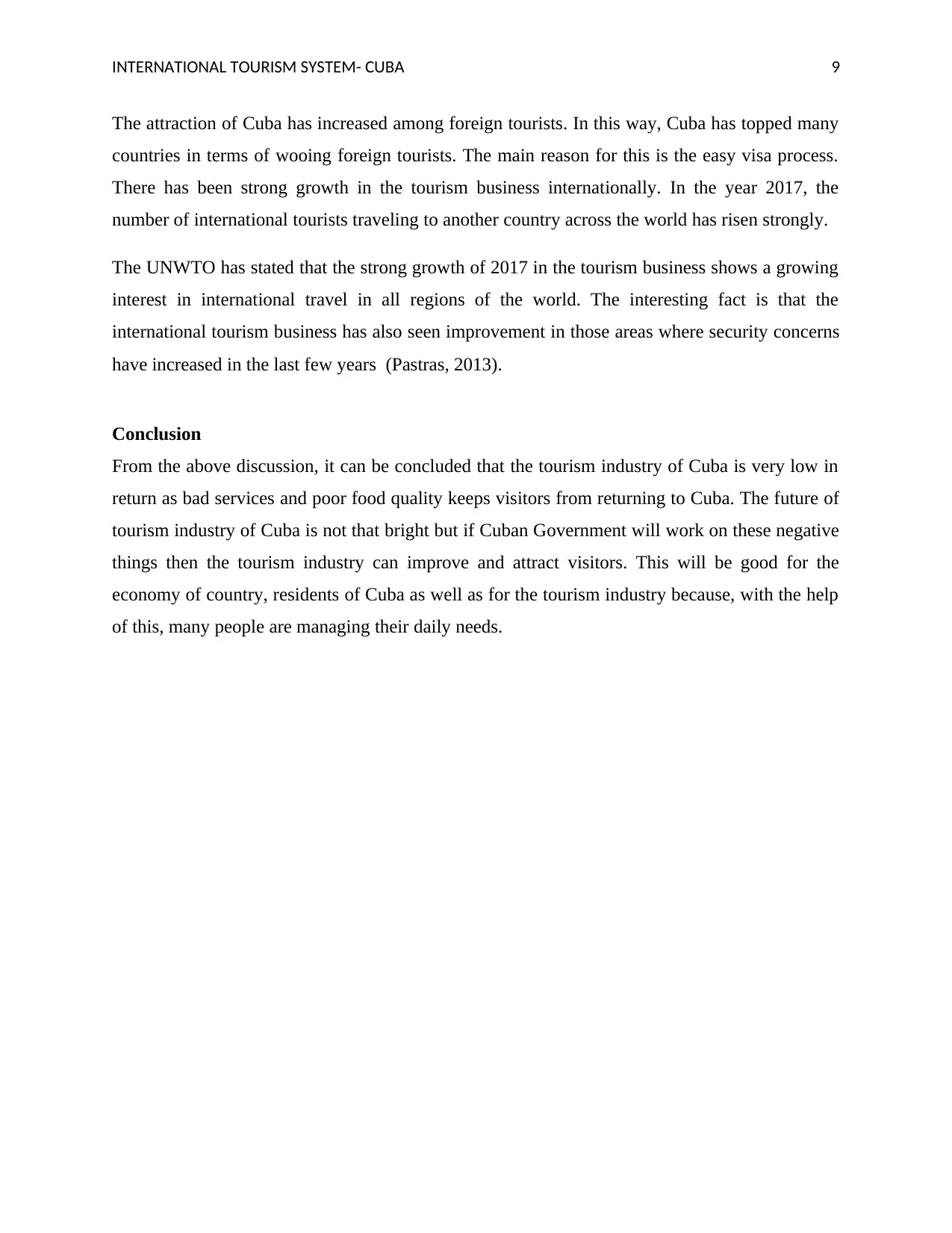
INTERNATIONAL TOURISM SYSTEM- CUBA 9
The attraction of Cuba has increased among foreign tourists. In this way, Cuba has topped many
countries in terms of wooing foreign tourists. The main reason for this is the easy visa process.
There has been strong growth in the tourism business internationally. In the year 2017, the
number of international tourists traveling to another country across the world has risen strongly.
The UNWTO has stated that the strong growth of 2017 in the tourism business shows a growing
interest in international travel in all regions of the world. The interesting fact is that the
international tourism business has also seen improvement in those areas where security concerns
have increased in the last few years (Pastras, 2013).
Conclusion
From the above discussion, it can be concluded that the tourism industry of Cuba is very low in
return as bad services and poor food quality keeps visitors from returning to Cuba. The future of
tourism industry of Cuba is not that bright but if Cuban Government will work on these negative
things then the tourism industry can improve and attract visitors. This will be good for the
economy of country, residents of Cuba as well as for the tourism industry because, with the help
of this, many people are managing their daily needs.
The attraction of Cuba has increased among foreign tourists. In this way, Cuba has topped many
countries in terms of wooing foreign tourists. The main reason for this is the easy visa process.
There has been strong growth in the tourism business internationally. In the year 2017, the
number of international tourists traveling to another country across the world has risen strongly.
The UNWTO has stated that the strong growth of 2017 in the tourism business shows a growing
interest in international travel in all regions of the world. The interesting fact is that the
international tourism business has also seen improvement in those areas where security concerns
have increased in the last few years (Pastras, 2013).
Conclusion
From the above discussion, it can be concluded that the tourism industry of Cuba is very low in
return as bad services and poor food quality keeps visitors from returning to Cuba. The future of
tourism industry of Cuba is not that bright but if Cuban Government will work on these negative
things then the tourism industry can improve and attract visitors. This will be good for the
economy of country, residents of Cuba as well as for the tourism industry because, with the help
of this, many people are managing their daily needs.
Paraphrase This Document
Need a fresh take? Get an instant paraphrase of this document with our AI Paraphraser
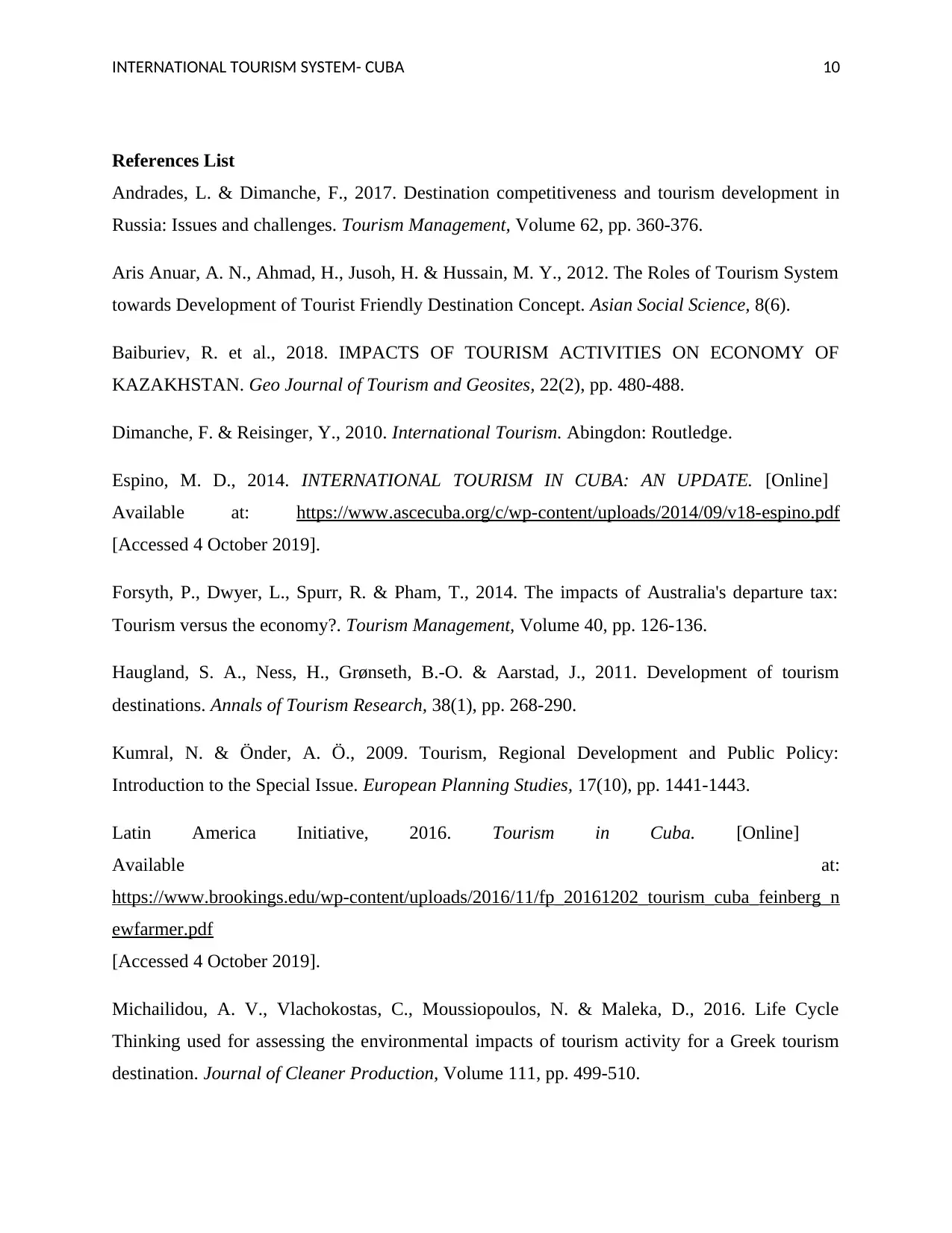
INTERNATIONAL TOURISM SYSTEM- CUBA 10
References List
Andrades, L. & Dimanche, F., 2017. Destination competitiveness and tourism development in
Russia: Issues and challenges. Tourism Management, Volume 62, pp. 360-376.
Aris Anuar, A. N., Ahmad, H., Jusoh, H. & Hussain, M. Y., 2012. The Roles of Tourism System
towards Development of Tourist Friendly Destination Concept. Asian Social Science, 8(6).
Baiburiev, R. et al., 2018. IMPACTS OF TOURISM ACTIVITIES ON ECONOMY OF
KAZAKHSTAN. Geo Journal of Tourism and Geosites, 22(2), pp. 480-488.
Dimanche, F. & Reisinger, Y., 2010. International Tourism. Abingdon: Routledge.
Espino, M. D., 2014. INTERNATIONAL TOURISM IN CUBA: AN UPDATE. [Online]
Available at: https://www.ascecuba.org/c/wp-content/uploads/2014/09/v18-espino.pdf
[Accessed 4 October 2019].
Forsyth, P., Dwyer, L., Spurr, R. & Pham, T., 2014. The impacts of Australia's departure tax:
Tourism versus the economy?. Tourism Management, Volume 40, pp. 126-136.
Haugland, S. A., Ness, H., Grønseth, B.-O. & Aarstad, J., 2011. Development of tourism
destinations. Annals of Tourism Research, 38(1), pp. 268-290.
Kumral, N. & Önder, A. Ö., 2009. Tourism, Regional Development and Public Policy:
Introduction to the Special Issue. European Planning Studies, 17(10), pp. 1441-1443.
Latin America Initiative, 2016. Tourism in Cuba. [Online]
Available at:
https://www.brookings.edu/wp-content/uploads/2016/11/fp_20161202_tourism_cuba_feinberg_n
ewfarmer.pdf
[Accessed 4 October 2019].
Michailidou, A. V., Vlachokostas, C., Moussiopoulos, Ν. & Maleka, D., 2016. Life Cycle
Thinking used for assessing the environmental impacts of tourism activity for a Greek tourism
destination. Journal of Cleaner Production, Volume 111, pp. 499-510.
References List
Andrades, L. & Dimanche, F., 2017. Destination competitiveness and tourism development in
Russia: Issues and challenges. Tourism Management, Volume 62, pp. 360-376.
Aris Anuar, A. N., Ahmad, H., Jusoh, H. & Hussain, M. Y., 2012. The Roles of Tourism System
towards Development of Tourist Friendly Destination Concept. Asian Social Science, 8(6).
Baiburiev, R. et al., 2018. IMPACTS OF TOURISM ACTIVITIES ON ECONOMY OF
KAZAKHSTAN. Geo Journal of Tourism and Geosites, 22(2), pp. 480-488.
Dimanche, F. & Reisinger, Y., 2010. International Tourism. Abingdon: Routledge.
Espino, M. D., 2014. INTERNATIONAL TOURISM IN CUBA: AN UPDATE. [Online]
Available at: https://www.ascecuba.org/c/wp-content/uploads/2014/09/v18-espino.pdf
[Accessed 4 October 2019].
Forsyth, P., Dwyer, L., Spurr, R. & Pham, T., 2014. The impacts of Australia's departure tax:
Tourism versus the economy?. Tourism Management, Volume 40, pp. 126-136.
Haugland, S. A., Ness, H., Grønseth, B.-O. & Aarstad, J., 2011. Development of tourism
destinations. Annals of Tourism Research, 38(1), pp. 268-290.
Kumral, N. & Önder, A. Ö., 2009. Tourism, Regional Development and Public Policy:
Introduction to the Special Issue. European Planning Studies, 17(10), pp. 1441-1443.
Latin America Initiative, 2016. Tourism in Cuba. [Online]
Available at:
https://www.brookings.edu/wp-content/uploads/2016/11/fp_20161202_tourism_cuba_feinberg_n
ewfarmer.pdf
[Accessed 4 October 2019].
Michailidou, A. V., Vlachokostas, C., Moussiopoulos, Ν. & Maleka, D., 2016. Life Cycle
Thinking used for assessing the environmental impacts of tourism activity for a Greek tourism
destination. Journal of Cleaner Production, Volume 111, pp. 499-510.
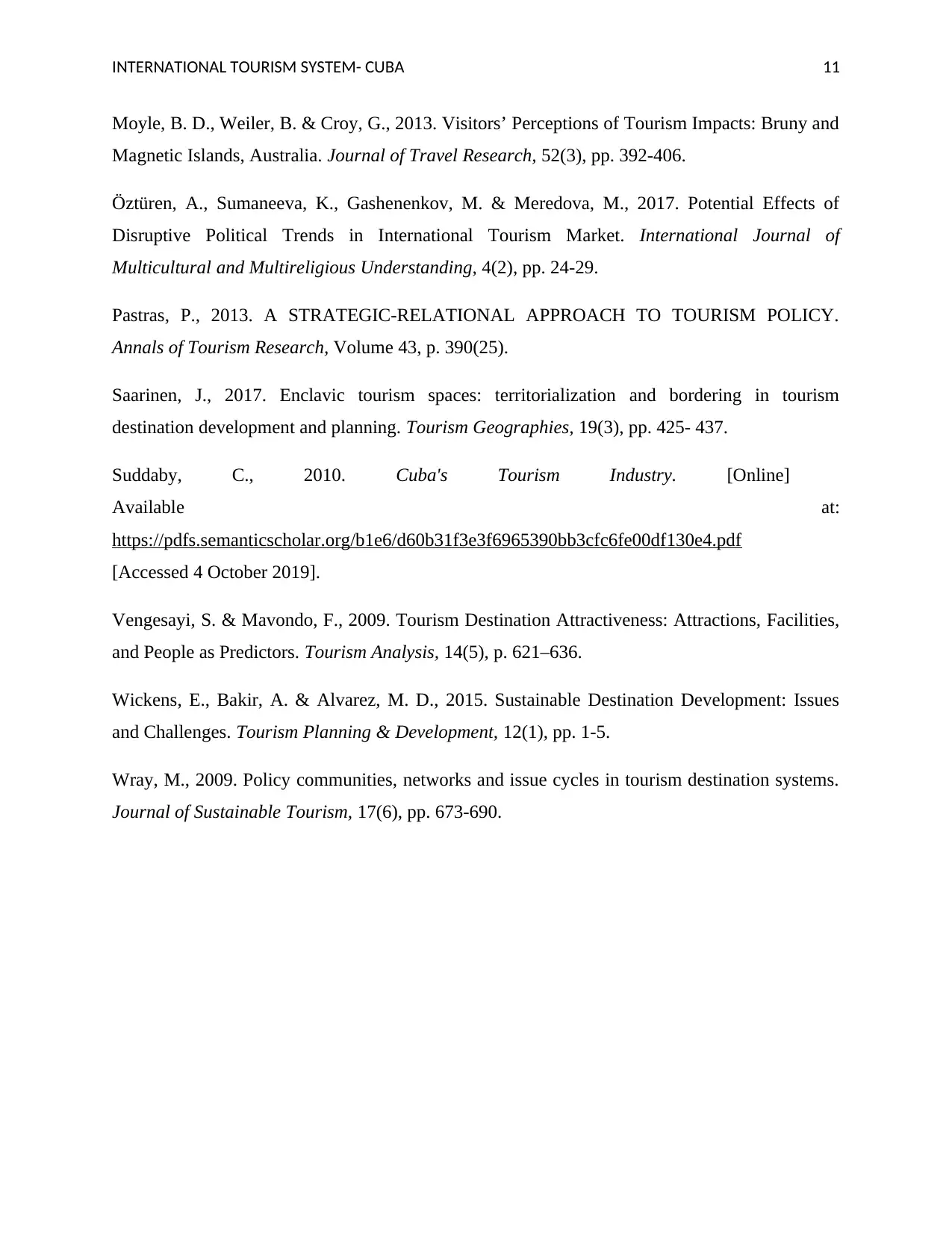
INTERNATIONAL TOURISM SYSTEM- CUBA 11
Moyle, B. D., Weiler, B. & Croy, G., 2013. Visitors’ Perceptions of Tourism Impacts: Bruny and
Magnetic Islands, Australia. Journal of Travel Research, 52(3), pp. 392-406.
Öztüren, A., Sumaneeva, K., Gashenenkov, M. & Meredova, M., 2017. Potential Effects of
Disruptive Political Trends in International Tourism Market. International Journal of
Multicultural and Multireligious Understanding, 4(2), pp. 24-29.
Pastras, P., 2013. A STRATEGIC-RELATIONAL APPROACH TO TOURISM POLICY.
Annals of Tourism Research, Volume 43, p. 390(25).
Saarinen, J., 2017. Enclavic tourism spaces: territorialization and bordering in tourism
destination development and planning. Tourism Geographies, 19(3), pp. 425- 437.
Suddaby, C., 2010. Cuba's Tourism Industry. [Online]
Available at:
https://pdfs.semanticscholar.org/b1e6/d60b31f3e3f6965390bb3cfc6fe00df130e4.pdf
[Accessed 4 October 2019].
Vengesayi, S. & Mavondo, F., 2009. Tourism Destination Attractiveness: Attractions, Facilities,
and People as Predictors. Tourism Analysis, 14(5), p. 621–636.
Wickens, E., Bakir, A. & Alvarez, M. D., 2015. Sustainable Destination Development: Issues
and Challenges. Tourism Planning & Development, 12(1), pp. 1-5.
Wray, M., 2009. Policy communities, networks and issue cycles in tourism destination systems.
Journal of Sustainable Tourism, 17(6), pp. 673-690.
Moyle, B. D., Weiler, B. & Croy, G., 2013. Visitors’ Perceptions of Tourism Impacts: Bruny and
Magnetic Islands, Australia. Journal of Travel Research, 52(3), pp. 392-406.
Öztüren, A., Sumaneeva, K., Gashenenkov, M. & Meredova, M., 2017. Potential Effects of
Disruptive Political Trends in International Tourism Market. International Journal of
Multicultural and Multireligious Understanding, 4(2), pp. 24-29.
Pastras, P., 2013. A STRATEGIC-RELATIONAL APPROACH TO TOURISM POLICY.
Annals of Tourism Research, Volume 43, p. 390(25).
Saarinen, J., 2017. Enclavic tourism spaces: territorialization and bordering in tourism
destination development and planning. Tourism Geographies, 19(3), pp. 425- 437.
Suddaby, C., 2010. Cuba's Tourism Industry. [Online]
Available at:
https://pdfs.semanticscholar.org/b1e6/d60b31f3e3f6965390bb3cfc6fe00df130e4.pdf
[Accessed 4 October 2019].
Vengesayi, S. & Mavondo, F., 2009. Tourism Destination Attractiveness: Attractions, Facilities,
and People as Predictors. Tourism Analysis, 14(5), p. 621–636.
Wickens, E., Bakir, A. & Alvarez, M. D., 2015. Sustainable Destination Development: Issues
and Challenges. Tourism Planning & Development, 12(1), pp. 1-5.
Wray, M., 2009. Policy communities, networks and issue cycles in tourism destination systems.
Journal of Sustainable Tourism, 17(6), pp. 673-690.
⊘ This is a preview!⊘
Do you want full access?
Subscribe today to unlock all pages.

Trusted by 1+ million students worldwide
1 out of 12
Related Documents
Your All-in-One AI-Powered Toolkit for Academic Success.
+13062052269
info@desklib.com
Available 24*7 on WhatsApp / Email
![[object Object]](/_next/static/media/star-bottom.7253800d.svg)
Unlock your academic potential
Copyright © 2020–2025 A2Z Services. All Rights Reserved. Developed and managed by ZUCOL.





